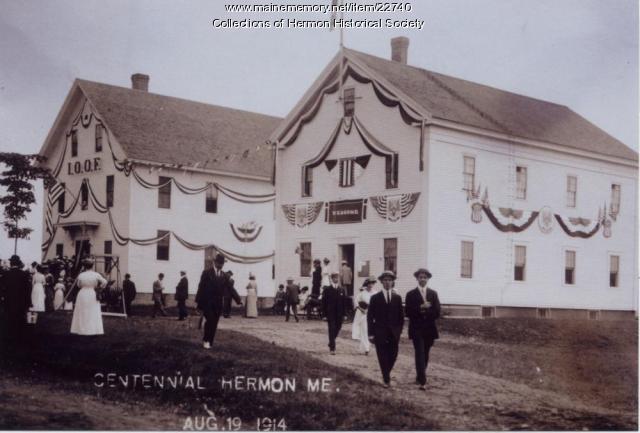Keywords: Religious buildings
Item 109079
Auditorium at the Wesleyan Grove Camp Meeting, Northport, ca. 1910
Contributed by: Penobscot Marine Museum Date: circa 1910 Location: Northport Media: Film Negative
Item 108657
Street view of Richmond Campground, Richmond, ca. 1910
Contributed by: Penobscot Marine Museum Date: circa 1910 Location: Richmond Media: Glass Plate Negative
Item 40303
Assessor's Record, 1397 Congress Street, Portland, 1924
Owner in 1924: Stroudwater Religious Society Use: Church
Item 148634
Portland Orthodox synagogue sanctuary, ca. 1954
Contributed by: Maine Historical Society Date: circa 1954 Location: Portland Client: Congregation Shaarey Tphiloh Architect: Perley F. Gilbert Associates
Item 109941
Sketch Plan for Arrangements and Planting about Buildings, Falmouth, 1913
Contributed by: Maine Historical Society Date: 1913 Location: Falmouth Client: unknown Architect: Olmsted Brothers
Exhibit
Anshe Sfard, Portland's Early Chassidic Congregation
Chassidic Jews who came to Portland from Eastern Europe formed a congregation in the late 19th century and, in 1917, built a synagogue -- Anshe Sfard -- on Cumberland Avenue in Portland. By the early 1960s, the congregation was largely gone. The building was demolished in 1983.
Exhibit
Shaarey Tphiloh, Portland's Orthodox Synagogue
Shaarey Tphiloh was founded in 1904 by immigrants from Eastern Europe. While accommodating to American society, the Orthodox synagogue also has retained many of its traditions.
Site Page
View collections, facts, and contact information for this Contributing Partner.
Site Page
View collections, facts, and contact information for this Contributing Partner.
Story
Story of the "little nun"
by Felicia Garant
My grandmother made a nun's outfit for me
Story
Sister Madeleine D’Anjou: Many detours lead to a rewarding life
by Biddeford Cultural & Heritage Center
What a journey! Sister Maddie says that "God writes straight on crooked lines."
Lesson Plan
Building Community/Community Buildings
Grade Level: 6-8
Content Area: Social Studies
Where do people gather? What defines a community? What buildings allow people to congregate to celebrate, learn, debate, vote, and take part in all manner of community activities? Students will evaluate images and primary documents from throughout Maine’s history, and look at some of Maine’s earliest gathering spaces and organizations, and how many communities established themselves around certain types of buildings. Students will make connections between the community buildings of the past and the ways we express identity and create communities today.
Lesson Plan
Longfellow Studies: "The Jewish Cemetery at Newport"
Grade Level: 6-8, 9-12
Content Area: English Language Arts, Social Studies
Longfellow's poem "The Jewish Cemetery at Newport" opens up the issue of the earliest history of the Jews in America, and the significant roles they played as businessmen and later benefactors to the greater community. The history of the building itself is notable in terms of early American architecture, its having been designed, apparently gratis, by the most noted architect of the day. Furthermore, the poem traces the history of Newport as kind of a microcosm of New England commercial cities before the industrialization boom. For almost any age student the poem could be used to open up interest in local cemeteries, which are almost always a wealth of curiousities and history. Longfellow and his friends enjoyed exploring cemeteries, and today our little local cemeteries can be used to teach little local histories and parts of the big picture as well.
Henry Wadsworth Longfellow visited the Jewish cemetery in Newport, RI on July 9, 1852. His popular poem about the site, published two years later, was certainly a sympathetic portrayal of the place and its people. In addition to Victorian romantic musings about the "Hebrews in their graves," Longfellow includes in this poem references to the historic persecution of the Jews, as well as very specific references to their religious practices.
Since the cemetery and the nearby synagogue were restored and protected with an infusion of funding just a couple years after Longfellow's visit, and later a congregation again assembled, his gloomy predictions about the place proved false (never mind the conclusion of the poem, "And the dead nations never rise again!"). Nevertheless, it is a fascinating poem, and an interesting window into the history of the nation's oldest extant synagogue.



















